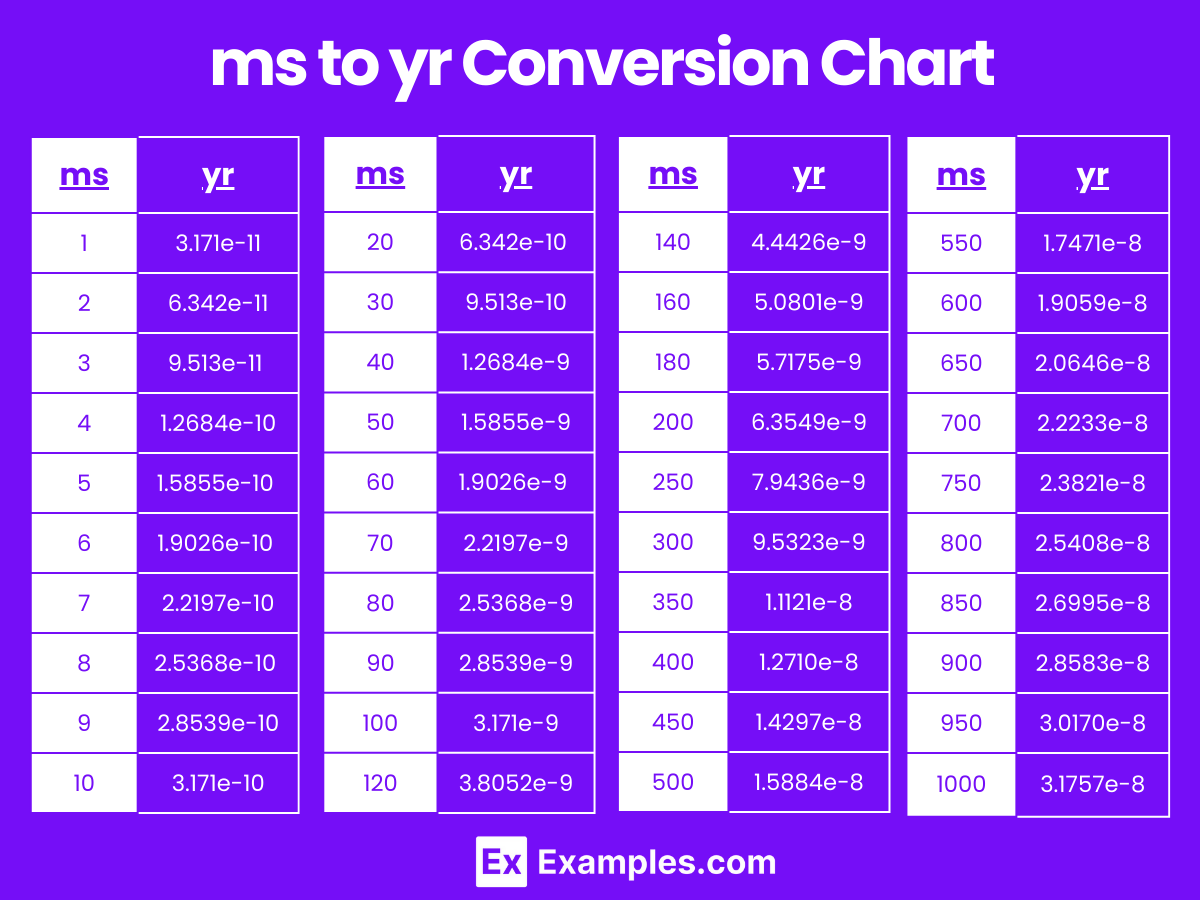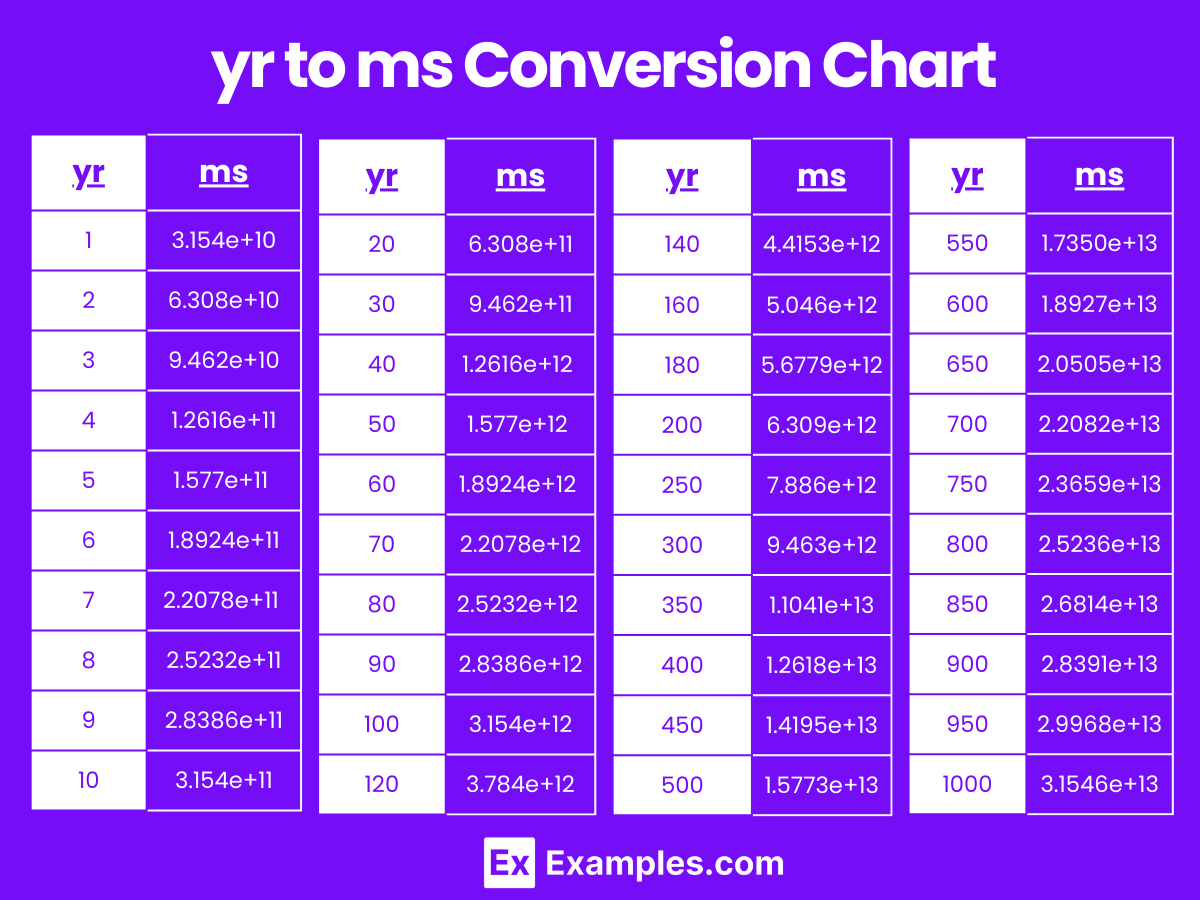Accurately convert milliseconds to years and vice versa at Examples.com. Enter your data for immediate and precise conversions.
ms to yr
Formula: Time in years(yr) = Time in milliseconds(ms) ∕ 31556952000
Milliseconds :
Years :
| milliseconds | years |
|---|---|
| 1 | 3.168873850681143e-11 |
yr to ms
Formula: Time in milliseconds(ms) = Time in years(yr)x 31556952000
Years :
Milliseconds :
| years | milliseconds |
|---|---|
| 1 | 31556952000 |
Time Converters to Millisecond (mm)
Time Converters to Calendar Year (yr)
Conversion Factors:
- Milliseconds to Years: 1 year = 31,536,000,000 milliseconds
- Years to Milliseconds: 1 millisecond = 1/31,536,000,000 years
How to Convert Milliseconds to Years:
To convert milliseconds to years, divide the number of milliseconds by 31,536,000,000.
Years=Milliseconds/31,536,000,000
Example: Convert 100,000,000,000 milliseconds to years.
Years=100,000,000,000/31,536,000,000=3.1689 years
How to Convert Years to Milliseconds:
To convert years to milliseconds, multiply the number of years by 31,536,000,000.
Milliseconds=Years×31,536,000,000
Example: Convert 2 years to milliseconds.
Milliseconds=2×31,536,000,000=63,072,000,000 milliseconds
Milliseconds to Years Conversion Table
| Milliseconds | Years |
|---|---|
| 1 ms | 3.171e-11 yr |
| 2 ms | 6.342e-11 yr |
| 3 ms | 9.513e-11 yr |
| 4 ms | 1.2684e-10 yr |
| 5 ms | 1.5855e-10 yr |
| 6 ms | 1.9026e-10 yr |
| 7 ms | 2.2197e-10 yr |
| 8 ms | 2.5368e-10 yr |
| 9 ms | 2.8539e-10 yr |
| 10 ms | 3.171e-10 yr |
| 20 ms | 6.342e-10 yr |
| 30 ms | 9.513e-10 yr |
| 40 ms | 1.2684e-9 yr |
| 50 ms | 1.5855e-9 yr |
| 60 ms | 1.9026e-9 yr |
| 70 ms | 2.2197e-9 yr |
| 80 ms | 2.5368e-9 yr |
| 90 ms | 2.8539e-9 yr |
| 100 ms | 3.171e-9 yr |
ms to yr Conversion Chart

Years to Milliseconds Conversion Table
| Years | Milliseconds |
|---|---|
| 1 yr | 3.154e+10 ms |
| 2 yr | 6.308e+10 ms |
| 3 yr | 9.462e+10 ms |
| 4 yr | 1.2616e+11 ms |
| 5 yr | 1.577e+11 ms |
| 6 yr | 1.8924e+11 ms |
| 7 yr | 2.2078e+11 ms |
| 8 yr | 2.5232e+11 ms |
| 9 yr | 2.8386e+11 ms |
| 10 yr | 3.154e+11 ms |
| 20 yr | 6.308e+11 ms |
| 30 yr | 9.462e+11 ms |
| 40 yr | 1.2616e+12 ms |
| 50 yr | 1.577e+12 ms |
| 60 yr | 1.8924e+12 ms |
| 70 yr | 2.2078e+12 ms |
| 80 yr | 2.5232e+12 ms |
| 90 yr | 2.8386e+12 ms |
| 100 yr | 3.154e+12 ms |
yr to ms Conversion Chart

Difference Between Milliseconds to Years
| Aspect | Milliseconds (ms) | Years (yr) |
|---|---|---|
| Definition | A unit of time equal to one thousandth of a second | A unit of time equal to 365.25 days |
| Usage | Used for precise measurements in computing and scientific experiments | Used for measuring longer durations in human history and nature |
| Conversion Factor | 1 ms = 3.171e-11 yr | 1 yr = 3.154e+10 ms |
| Time Span | Represents very short durations | Represents long periods of time |
| Common Context | Typically used in technology, physics, and high-speed events | Used in calendars, historical records, and aging |
| Measurement Precision | High precision for short events | Low precision for long-term events |
| Example | 10 ms is the time it takes for a computer to process a simple task | 1 year is the time it takes for Earth to orbit the Sun |
| Relevance | Critical in fields requiring fine-grained time measurement | Essential in everyday life for planning and understanding historical timelines |
1. Solved Examples on Converting Milliseconds to Years
Example 1
Problem: Convert 31,536,000,000 milliseconds to years.
Solution: 31,536,000,000 milliseconds ÷ 31,536,000,000 milliseconds/year = 1 year
Example 2
Problem: Convert 63,072,000,000 milliseconds to years.
Solution: 63,072,000,000 milliseconds ÷ 31,536,000,000 milliseconds/year = 2 years
Example 3
Problem: Convert 15,768,000,000 milliseconds to years.
Solution: 15,768,000,000 milliseconds ÷ 31,536,000,000 milliseconds/year = 0.5 years
Example 4
Problem: Convert 94,608,000,000 milliseconds to years.
Solution: 94,608,000,000 milliseconds ÷ 31,536,000,000 milliseconds/year = 3 years
Example 5
Problem: Convert 157,680,000,000 milliseconds to years.
Solution: 157,680,000,000 milliseconds ÷ 31,536,000,000 milliseconds/year = 5 years
2. Solved Examples on Converting Years to Milliseconds
Example 1
Problem: Convert 1 year to milliseconds.
Solution: 1 year × 31,536,000,000 milliseconds/year = 31,536,000,000 milliseconds
Example 2
Problem: Convert 2 years to milliseconds.
Solution: 2 years × 31,536,000,000 milliseconds/year = 63,072,000,000 milliseconds
Example 3
Problem: Convert 0.5 years to milliseconds.
Solution: 0.5 years × 31,536,000,000 milliseconds/year = 15,768,000,000 milliseconds
Example 4
Problem: Convert 3 years to milliseconds.
Solution: 3 years × 31,536,000,000 milliseconds/year = 94,608,000,000 milliseconds
Example 5
Problem: Convert 5 years to milliseconds.
Solution: 5 years × 31,536,000,000 milliseconds/year = 157,680,000,000 milliseconds
Are there tools available for converting milliseconds to years?
Yes, various online calculators and conversion tools can convert milliseconds to years. Enter the number of milliseconds, and the tool provides the equivalent in years.
Why is understanding milliseconds to years important in sports?
In sports, especially in races, milliseconds can determine the winner. Precise timing is crucial for fairness and accuracy in recording athletes’ performances.
Can milliseconds to years be significant in audio and video editing?
Yes, milliseconds are significant in audio and video editing for precise synchronization of tracks, frames, and effects. Accurate timing ensures smooth playback and alignment.
What is the significance of converting milliseconds to years in scientific research?
In scientific research, converting milliseconds to years helps in understanding processes that span vast time scales, such as geological events, evolutionary biology, and the age of astronomical objects.
How can converting milliseconds to years be useful in transportation?
In transportation, converting milliseconds to years aids in the design and maintenance of infrastructure such as roads, bridges, and railways. It ensures that these structures are safe and functional over their expected lifespan.

